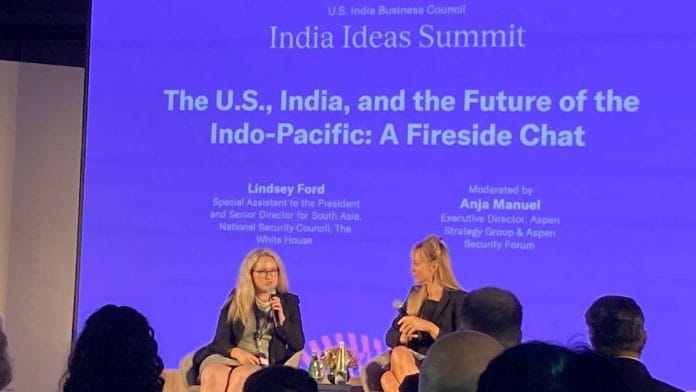New Delhi: As the world’s largest democracies, cooperation between India and the US on defence and infrastructure projects could offer an alternative to China for countries around the world, especially across the Indo-Pacific, White House official Lindsey W. Ford said Thursday.
Ford is in New Delhi for the India Ideas Summit 2024 hosted by the US-India Business Council.
“In the South China Sea, the only ISR (intelligence, surveillance and reconnaissance equipment) countries can get, to see what is happening in the region, is what they can purchase from the Chinese. India and the US working together could offer them an alternative,” said Ford, who is Special Assistant to the US President and Senior Director for South Asia at the National Security Council.
According to Ford, a lot of countries in the Indo-Pacific are increasingly questioning the role China should have in their critical infrastructure—areas such as 5G technologies—and the India-US partnership can be the needed alternative to Beijing in the region.
Ford explained that among the key sectors of cooperation in recent years, it is the partnership in defence that offers a clear example of the deepening ties between the two countries.
“Last year, the Biden administration agreed to the largest ever jet engine deal for co-production here in India… iCET (US-India Initiative on Critical and Emerging Technology) was explicitly designed to work… the jet engine deal is an example of how licensing rules were changed, especially if it is in the national interest of the US,” she said.
In June 2023, US company General Electric (GE) signed a Memorandum of Understanding (MoU) with Hindustan Aeronautics Limited (HAL) to jointly produce fighter jet engines for the Indian Air Force (IAF). The deal includes the potential joint production of GE Aerospace’s F414 engines in India.
The agreement between GE and HAL could potentially end India’s almost six-decade search to manufacture its own jet engines. The level of transfer of technology (ToT) by the US to India over the deal was a key pillar of National Security Adviser (NSA) Ajit Doval’s talks with his American counterpart Jake Sullivan, during his visit to Washington D.C. in January 2023.
It was during that visit that the two countries operationalised iCET, which has since had two NSA-level meetings.
However, ties between India and US have hit a rough patch since November 2023, when an Indian national was indicted by a US court in a murder-for-hire plot. The Indian national, Nikhil Gupta, was arrested by Czech authorities in June 2023, and is alleged to be behind a plot to murder Sikh extremist Gurpatwant Singh Pannun, who is a US citizen.
This July, ties were further impacted after Prime Minister Narendra Modi visited Russia in the same week that Washington D.C. was hosting the leaders of the North Atlantic Treaty Organisation (NATO) for its 75th founding anniversary summit.
The US State Department had expressed disappointment over the timing and symbolism of Modi’s visit to Russia.
Also read: India & Ireland aim to build strategic partnership, may announce joint economic commission this year
‘Faster licensing approval’
As part of the deepening of ties between India and the US, Ford pointed out that Indian companies have been able to bring in licensing requests, which have seen quicker approval thanks to the iCET initiative.
Ford added that defence start-ups in India, which lack testing capabilities to scale up their products, are being supported by a consortium of almost 20 US companies and government agencies to test their equipment. This includes equipment for ISR or even drones.
“More and more, we are headed towards deeper collaboration. It would be good to have US ISR systems using Indian sensors,” said Ford.
However, she conceded that one of the challenges has been the inability to remove regulations on both sides “as fast as we need to”.
The Quad (grouping of India, US, Australia and Japan) mini-lateral forum is also looking to expand cooperation to see how it can ensure real-time low-cost data to about 20 countries in the Indo-Pacific region for their maritime security, added Ford.
The Quad, which was turned into a leaders’ level dialogue under US President Joe Biden in 2021, has seen broadening cooperation among the countries, with 16 working groups covering expansive areas, including communication technology, disaster relief and cooperation on counter-terrorism efforts.
(Edited by Nida Fatima Siddiqui)
Also Read: Inside story of why India’s military worked to push mega US drone deal






